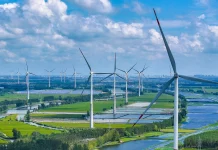JHIMPIR: On the vast desert of Jhimpir, hundreds of wind turbines are running day and night, providing stable power to the national grid.
In the emerging wind corridor, there are 12 projects executed by PowerChina. According to the company official, they have generated 1888.29 GWh of electricity so far.
“Not only electricity, these projects have also provided enormous employment opportunities. Most of the engineers, managers, and workers are from nearby areas”, Peerzada Zain ul Abideen, O&M manager of PowerChina HDEC Engineering Company Limited Pakistan and recipient of the award for outstanding Pakistani staff in CPEC projects 2022 told China Economic Net (CEN). Since working in the company in 2019, he has been coordinating with project management teams during the engineering and execution of 12 wind power projects.
He told CEN reporter that as of June 2022, the company has completed the design, procurement, and construction of 22 wind power plants in Pakistan, completed a total of 1090 MW of wind power installed capacity, built 22 sets of 132 KV substations, completed the installation and commissioning of 583 units wind turbines, laid nearly 300 kilometers of medium-voltage cables, generated more than 2 billion kWh of green energy to Pakistan’s power grid every year, and reduced carbon dioxide emissions by about 2 million tons.
Chinese power companies have become an indispensable part of Pakistan to realize its wind potential.
Muhammad Waqas, who works for the UEP 100MW wind farm in Jhimpir and also receives the award for outstanding Pakistani staff in CPEC projects, shares that state-of-the-art technologies are being transferred to Pakistan.
“Before the pandemic, I went to China every year to learn about power-related technologies and business know-how”, he said, adding, “Relying on wind power alone, Pakistan can produce twice the amount of electricity needed in the country. With the passage of time, the project development, construction and operations cost are reducing, which will ultimately reduce power tariff, which is connected with high economic activities.”
The project “Assessment and Regulation Mechanism of Climate Change Impacts on Water-energy-food Linkages in typical Regions of China and Pakistan”, jointly submitted by Chinese and Pakistani research institutes, has been successfully approved recently.
As an international (regional) cooperation and exchange project under China’s National Natural Science Foundation, it was jointly applied by Changjiang River Scientific Research Institute (CRSRI) and Lasbela University of Agriculture, Water and Marine Sciences. It is also the second such project of CRSRI approved in nearly 20 years.
Based on its research on “Water Cycle Patterns and Effects of Water Conservation and Emission Reduction in Irrigation Areas of Yangtze River Basin”, CRSRI plans to cooperate with its Pakistani counterpart to explore the impact of climate change on water-energy-food linkages between China and Pakistan. –Agencies
Home CHINA-CPEC-BRI PowerChina Wind power clusters in Jhimpir have generated 1888.29 GWh Electricity





